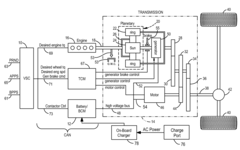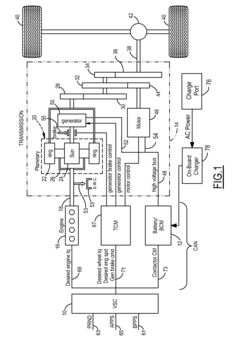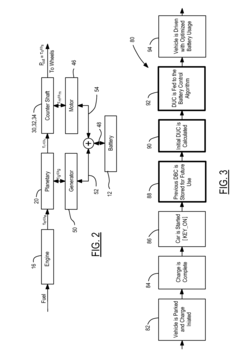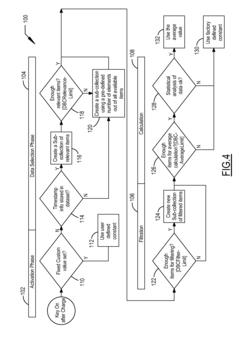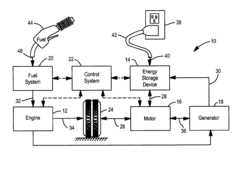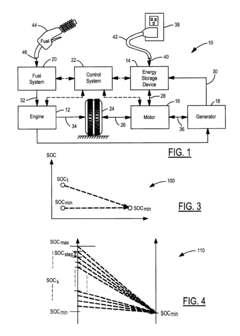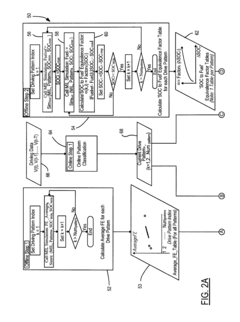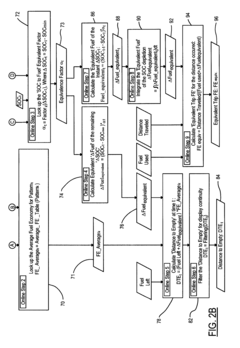PHEV potential in electric aviation sector
AUG 14, 20259 MIN READ
Generate Your Research Report Instantly with AI Agent
Patsnap Eureka helps you evaluate technical feasibility & market potential.
PHEV Aviation Background
The aviation industry has long been dominated by conventional fossil fuel-powered aircraft, but the growing concern over environmental impact and the need for sustainable transportation solutions have led to increased interest in electric aviation. Plug-in Hybrid Electric Vehicle (PHEV) technology, which has proven successful in the automotive sector, is now being explored as a potential solution for the aviation industry.
PHEV technology in aviation combines the benefits of electric propulsion with the range and reliability of traditional combustion engines. This hybrid approach aims to reduce emissions, improve fuel efficiency, and pave the way for a gradual transition to fully electric aircraft. The concept involves integrating electric motors and battery systems with conventional aircraft engines, allowing for electric-only operation during certain flight phases while relying on combustion engines for extended range and power when needed.
The development of PHEV technology for aviation is driven by several factors, including the global push for reduced carbon emissions, rising fuel costs, and advancements in battery technology. As the aviation industry faces increasing pressure to meet stringent environmental regulations, PHEV systems offer a promising intermediate step towards greener air travel.
Early experiments with hybrid-electric propulsion in aviation date back to the early 2000s, with several small-scale demonstrator projects showcasing the potential of this technology. However, it is only in recent years that significant progress has been made in scaling up PHEV systems for larger aircraft and commercial applications.
The aviation industry's interest in PHEV technology has been further fueled by successful implementations in other transportation sectors, particularly the automotive industry. The lessons learned from developing and deploying hybrid vehicles on the road are now being applied to overcome the unique challenges posed by aviation, such as weight constraints, power requirements, and safety considerations.
As research and development in this field intensify, various stakeholders, including aircraft manufacturers, engine suppliers, and technology companies, are investing in PHEV aviation projects. These efforts range from retrofitting existing aircraft with hybrid-electric systems to designing entirely new aircraft architectures optimized for hybrid propulsion.
The potential benefits of PHEV technology in aviation extend beyond environmental considerations. It offers the possibility of reduced operating costs through improved fuel efficiency, lower maintenance requirements for electric components, and the ability to operate in noise-sensitive areas using electric-only mode during takeoff and landing.
PHEV technology in aviation combines the benefits of electric propulsion with the range and reliability of traditional combustion engines. This hybrid approach aims to reduce emissions, improve fuel efficiency, and pave the way for a gradual transition to fully electric aircraft. The concept involves integrating electric motors and battery systems with conventional aircraft engines, allowing for electric-only operation during certain flight phases while relying on combustion engines for extended range and power when needed.
The development of PHEV technology for aviation is driven by several factors, including the global push for reduced carbon emissions, rising fuel costs, and advancements in battery technology. As the aviation industry faces increasing pressure to meet stringent environmental regulations, PHEV systems offer a promising intermediate step towards greener air travel.
Early experiments with hybrid-electric propulsion in aviation date back to the early 2000s, with several small-scale demonstrator projects showcasing the potential of this technology. However, it is only in recent years that significant progress has been made in scaling up PHEV systems for larger aircraft and commercial applications.
The aviation industry's interest in PHEV technology has been further fueled by successful implementations in other transportation sectors, particularly the automotive industry. The lessons learned from developing and deploying hybrid vehicles on the road are now being applied to overcome the unique challenges posed by aviation, such as weight constraints, power requirements, and safety considerations.
As research and development in this field intensify, various stakeholders, including aircraft manufacturers, engine suppliers, and technology companies, are investing in PHEV aviation projects. These efforts range from retrofitting existing aircraft with hybrid-electric systems to designing entirely new aircraft architectures optimized for hybrid propulsion.
The potential benefits of PHEV technology in aviation extend beyond environmental considerations. It offers the possibility of reduced operating costs through improved fuel efficiency, lower maintenance requirements for electric components, and the ability to operate in noise-sensitive areas using electric-only mode during takeoff and landing.
Electric Aviation Market
The electric aviation market is experiencing rapid growth and transformation, driven by increasing environmental concerns and technological advancements. This sector encompasses a wide range of aircraft, from small personal air vehicles to larger commercial planes, all powered by electric propulsion systems. The market is currently in its nascent stages but shows significant potential for expansion in the coming decades.
One of the primary drivers of the electric aviation market is the growing emphasis on reducing carbon emissions in the transportation sector. As governments worldwide implement stricter environmental regulations, airlines and aircraft manufacturers are increasingly turning to electric propulsion as a viable solution. This shift is further supported by advancements in battery technology, which are gradually improving the range and performance capabilities of electric aircraft.
The market is segmented into various categories based on aircraft type, including fixed-wing, rotary-wing, and hybrid VTOL (Vertical Take-Off and Landing) aircraft. Each segment presents unique opportunities and challenges, with different technological requirements and market applications. Fixed-wing electric aircraft are particularly promising for short-haul commercial flights, while electric VTOL aircraft are gaining traction in the urban air mobility sector.
Several key players are emerging in the electric aviation market, including established aerospace companies and innovative startups. These companies are investing heavily in research and development to overcome the technical challenges associated with electric propulsion in aviation, such as battery energy density, power management systems, and lightweight materials.
The market is also witnessing a surge in partnerships and collaborations between technology companies, aircraft manufacturers, and energy providers. These alliances aim to accelerate the development and commercialization of electric aircraft by combining expertise in areas such as battery technology, aerodynamics, and electric propulsion systems.
Despite the promising outlook, the electric aviation market faces several challenges. The most significant hurdle is the current limitations of battery technology, which restricts the range and payload capacity of electric aircraft. Additionally, the need for substantial infrastructure investments, including charging stations and grid upgrades at airports, poses a challenge to widespread adoption.
Looking ahead, the electric aviation market is expected to see substantial growth, particularly in the short-haul and regional flight segments. As battery technology continues to improve and costs decrease, the viability of electric aircraft for longer routes will increase. The market is also likely to benefit from growing consumer demand for sustainable travel options and potential government incentives promoting the adoption of electric aviation technologies.
One of the primary drivers of the electric aviation market is the growing emphasis on reducing carbon emissions in the transportation sector. As governments worldwide implement stricter environmental regulations, airlines and aircraft manufacturers are increasingly turning to electric propulsion as a viable solution. This shift is further supported by advancements in battery technology, which are gradually improving the range and performance capabilities of electric aircraft.
The market is segmented into various categories based on aircraft type, including fixed-wing, rotary-wing, and hybrid VTOL (Vertical Take-Off and Landing) aircraft. Each segment presents unique opportunities and challenges, with different technological requirements and market applications. Fixed-wing electric aircraft are particularly promising for short-haul commercial flights, while electric VTOL aircraft are gaining traction in the urban air mobility sector.
Several key players are emerging in the electric aviation market, including established aerospace companies and innovative startups. These companies are investing heavily in research and development to overcome the technical challenges associated with electric propulsion in aviation, such as battery energy density, power management systems, and lightweight materials.
The market is also witnessing a surge in partnerships and collaborations between technology companies, aircraft manufacturers, and energy providers. These alliances aim to accelerate the development and commercialization of electric aircraft by combining expertise in areas such as battery technology, aerodynamics, and electric propulsion systems.
Despite the promising outlook, the electric aviation market faces several challenges. The most significant hurdle is the current limitations of battery technology, which restricts the range and payload capacity of electric aircraft. Additionally, the need for substantial infrastructure investments, including charging stations and grid upgrades at airports, poses a challenge to widespread adoption.
Looking ahead, the electric aviation market is expected to see substantial growth, particularly in the short-haul and regional flight segments. As battery technology continues to improve and costs decrease, the viability of electric aircraft for longer routes will increase. The market is also likely to benefit from growing consumer demand for sustainable travel options and potential government incentives promoting the adoption of electric aviation technologies.
PHEV Tech Challenges
The development of Plug-in Hybrid Electric Vehicles (PHEVs) in the aviation sector faces several significant technical challenges that need to be addressed for successful implementation. One of the primary obstacles is the power-to-weight ratio of current battery technologies. Aviation applications demand high energy density to minimize weight while maximizing range, a requirement that current lithium-ion batteries struggle to meet efficiently.
Another critical challenge lies in the integration of hybrid propulsion systems within aircraft structures. The complexity of combining traditional combustion engines with electric motors and batteries presents design and engineering hurdles. Ensuring seamless power transitions between electric and combustion modes while maintaining optimal performance and safety is a complex task that requires sophisticated control systems and algorithms.
Thermal management poses a substantial challenge in PHEV aviation applications. The high-power demands of electric propulsion systems generate significant heat, which must be effectively dissipated to prevent component degradation and ensure safe operation. Developing efficient cooling systems that do not add excessive weight or complexity to the aircraft is a key area of focus for researchers and engineers.
The charging infrastructure for PHEV aircraft presents another set of challenges. Unlike ground-based vehicles, aircraft require rapid charging capabilities to maintain operational efficiency and minimize turnaround times. Developing high-power charging systems that can quickly and safely recharge aircraft batteries without compromising their longevity is a critical area of research.
Reliability and safety considerations are paramount in aviation, and PHEV systems introduce new potential failure modes that must be thoroughly addressed. Redundancy in critical systems, fail-safe mechanisms, and robust battery management systems are essential to ensure the safety and reliability of PHEV aircraft. Additionally, regulatory frameworks and certification processes for hybrid-electric aircraft are still evolving, presenting challenges in terms of compliance and standardization.
The environmental impact of PHEV aviation technology, while potentially beneficial in terms of emissions reduction, also presents challenges. The lifecycle assessment of batteries, including their production, use, and disposal, must be carefully considered to ensure that the overall environmental footprint of PHEV aircraft is indeed lower than conventional alternatives.
Lastly, the economic viability of PHEV technology in aviation remains a significant challenge. The high costs associated with developing and implementing hybrid-electric propulsion systems, coupled with the need for new infrastructure and maintenance procedures, require careful economic analysis and strategic planning to ensure long-term sustainability and market adoption.
Another critical challenge lies in the integration of hybrid propulsion systems within aircraft structures. The complexity of combining traditional combustion engines with electric motors and batteries presents design and engineering hurdles. Ensuring seamless power transitions between electric and combustion modes while maintaining optimal performance and safety is a complex task that requires sophisticated control systems and algorithms.
Thermal management poses a substantial challenge in PHEV aviation applications. The high-power demands of electric propulsion systems generate significant heat, which must be effectively dissipated to prevent component degradation and ensure safe operation. Developing efficient cooling systems that do not add excessive weight or complexity to the aircraft is a key area of focus for researchers and engineers.
The charging infrastructure for PHEV aircraft presents another set of challenges. Unlike ground-based vehicles, aircraft require rapid charging capabilities to maintain operational efficiency and minimize turnaround times. Developing high-power charging systems that can quickly and safely recharge aircraft batteries without compromising their longevity is a critical area of research.
Reliability and safety considerations are paramount in aviation, and PHEV systems introduce new potential failure modes that must be thoroughly addressed. Redundancy in critical systems, fail-safe mechanisms, and robust battery management systems are essential to ensure the safety and reliability of PHEV aircraft. Additionally, regulatory frameworks and certification processes for hybrid-electric aircraft are still evolving, presenting challenges in terms of compliance and standardization.
The environmental impact of PHEV aviation technology, while potentially beneficial in terms of emissions reduction, also presents challenges. The lifecycle assessment of batteries, including their production, use, and disposal, must be carefully considered to ensure that the overall environmental footprint of PHEV aircraft is indeed lower than conventional alternatives.
Lastly, the economic viability of PHEV technology in aviation remains a significant challenge. The high costs associated with developing and implementing hybrid-electric propulsion systems, coupled with the need for new infrastructure and maintenance procedures, require careful economic analysis and strategic planning to ensure long-term sustainability and market adoption.
Current PHEV Solutions
01 Powertrain and energy management systems
PHEV technology incorporates advanced powertrain and energy management systems to optimize the use of both electric and internal combustion engines. These systems control the power distribution between the two energy sources, manage battery charging, and improve overall vehicle efficiency.- Power management systems for PHEVs: Advanced power management systems are crucial for optimizing the performance of plug-in hybrid electric vehicles. These systems control the distribution of power between the electric motor and internal combustion engine, manage battery charging, and improve overall energy efficiency. They also incorporate intelligent algorithms to predict and adapt to driving conditions, enhancing the vehicle's range and fuel economy.
- Battery technology and charging infrastructure: Innovations in battery technology and charging infrastructure are key to the advancement of PHEVs. This includes the development of high-capacity, fast-charging batteries, as well as the implementation of smart charging systems. Improved battery management systems help extend battery life and optimize charging cycles. Additionally, the expansion of charging networks and the integration of vehicle-to-grid (V2G) technology are enhancing the practicality and adoption of PHEVs.
- Drivetrain and transmission systems: PHEV technology focuses on developing advanced drivetrain and transmission systems that seamlessly integrate electric and combustion power sources. This includes the design of efficient electric motors, power split devices, and continuously variable transmissions. These innovations aim to improve power delivery, reduce energy losses, and enhance the overall driving experience of PHEVs.
- Regenerative braking and energy recovery: Regenerative braking systems are a crucial component of PHEV technology, allowing vehicles to recover and store energy typically lost during deceleration. Advanced energy recovery systems capture kinetic energy and convert it into electrical energy, which is then stored in the battery. This technology significantly improves the overall efficiency of PHEVs and extends their electric driving range.
- Lightweight materials and aerodynamic design: The use of lightweight materials and aerodynamic design principles plays a significant role in improving PHEV efficiency. Advanced materials such as carbon fiber composites and high-strength alloys are used to reduce vehicle weight without compromising safety. Aerodynamic optimizations, including active grille shutters and underbody panels, help minimize drag and improve energy efficiency, ultimately extending the vehicle's range and performance.
02 Battery and charging technologies
PHEVs utilize high-capacity batteries and advanced charging technologies to enable extended electric-only driving range. This includes fast-charging capabilities, regenerative braking systems, and intelligent battery management to prolong battery life and optimize performance.Expand Specific Solutions03 Hybrid drivetrain configurations
Various hybrid drivetrain configurations are employed in PHEVs, including series, parallel, and power-split systems. These configurations determine how the electric motor and internal combustion engine work together to propel the vehicle and affect overall efficiency and performance.Expand Specific Solutions04 Control strategies and algorithms
Advanced control strategies and algorithms are developed to optimize PHEV performance, including predictive energy management, adaptive cruise control, and intelligent driving mode selection. These systems use real-time data and machine learning to enhance efficiency and driving experience.Expand Specific Solutions05 Integration with smart grid and V2G technologies
PHEVs are designed to integrate with smart grid systems and vehicle-to-grid (V2G) technologies. This allows for bidirectional power flow, enabling PHEVs to not only charge from the grid but also potentially supply power back to the grid during peak demand periods or emergencies.Expand Specific Solutions
Key PHEV Aviation Players
The research on PHEV potential in the electric aviation sector is in its early stages, with the market still emerging and relatively small. The technology is not yet mature, but shows promise for reducing emissions in short-range flights. Key players like Honeywell, Beta Air, and Toyota are investing in R&D, while established aerospace companies such as Commercial Aircraft Corporation of China and Ford are exploring applications. Universities including Nanjing University of Aeronautics & Astronautics and Carnegie Mellon are contributing research. The competitive landscape is evolving rapidly as both startups and major corporations vie to develop viable PHEV aircraft solutions.
Honeywell International Technologies Ltd.
Technical Solution: Honeywell is developing advanced PHEV systems for electric aviation, focusing on hybrid-electric propulsion technologies. Their approach combines traditional turbine engines with electric motors and batteries, allowing for reduced emissions and improved fuel efficiency. Honeywell's system integrates power electronics, electric motors, and energy storage solutions to optimize performance across different flight phases[1]. The company has demonstrated a 1-megawatt generator, which is powerful enough to support hybrid-electric aircraft in the regional and narrowbody segments[2]. Honeywell is also working on advanced thermal management systems to address the heat generation challenges in electric aviation[3].
Strengths: Extensive aerospace experience, advanced power electronics expertise, and integrated system approach. Weaknesses: Potential limitations in battery technology compared to pure EV specialists.
Beta Air LLC
Technical Solution: Beta Air is pioneering PHEV technology in electric aviation with their ALIA aircraft. The company's approach combines electric propulsion with a sustainable aviation fuel (SAF) range extender, allowing for extended flight range and reduced emissions. Beta's PHEV system utilizes a distributed electric propulsion architecture with multiple electric motors powered by batteries and a turbine generator[4]. The ALIA aircraft is designed to carry 1,400 pounds of cargo or up to six people, with a range of 250 nautical miles in full-electric mode and up to 450 nautical miles in hybrid mode[5]. Beta Air is also developing a comprehensive charging infrastructure to support their PHEV aircraft operations.
Strengths: Purpose-built PHEV aircraft design, focus on practical applications like cargo and passenger transport. Weaknesses: Limited track record compared to established aerospace companies.
PHEV Aviation Patents
Adaptive Initial Estimation and Dynamic Determination and Update of Distance Until Charge of a Plug-In Hybrid Electric Vehicle
PatentActiveUS20110184600A1
Innovation
- A method and system that dynamically control battery usage based on the estimated or user-provided 'distance until charge' (DUC) value, utilizing historical data and real-time information from navigation systems to optimize battery depletion and charging strategies.
Plug-in hybrid electric vehicle and method of control for providing distance to empty and equivalent trip fuel economy information
PatentActiveUS8406948B2
Innovation
- A method for calculating DTE and equivalent Trip Fuel Economy (FE) that involves a controller determining the battery equivalent fuel amount using an equivalence factor based on SOC and driving conditions, and converting electricity consumption into fuel consumption for a unified efficiency index in miles per gallon (MPG), leveraging existing driving pattern identification and high-fidelity PHEV models to provide accurate and adaptive readouts.
Regulatory Framework
The regulatory framework surrounding Plug-in Hybrid Electric Vehicles (PHEVs) in the aviation sector is complex and evolving. As the industry explores the potential of electric propulsion systems, governments and international bodies are working to establish guidelines that ensure safety, environmental protection, and fair competition.
At the international level, the International Civil Aviation Organization (ICAO) plays a crucial role in setting standards for aircraft emissions and noise. ICAO's Committee on Aviation Environmental Protection (CAEP) is actively developing new certification standards for electric and hybrid aircraft, which will likely influence national regulations worldwide.
In the United States, the Federal Aviation Administration (FAA) is at the forefront of developing regulations for electric and hybrid aircraft. The FAA's Part 23 Amendment 64 has introduced a more flexible, performance-based approach to aircraft certification, which is particularly beneficial for innovative propulsion systems like those used in PHEVs.
The European Union Aviation Safety Agency (EASA) has also been proactive in addressing the regulatory challenges posed by electric and hybrid aircraft. EASA's Special Condition for Electric/Hybrid Propulsion Systems provides a framework for certifying these novel technologies, focusing on safety and reliability.
Environmental regulations are a significant driver for PHEV development in aviation. The EU's Emissions Trading System (ETS) and ICAO's Carbon Offsetting and Reduction Scheme for International Aviation (CORSIA) create economic incentives for airlines to adopt more fuel-efficient technologies, including PHEVs.
Airworthiness directives and operational regulations are being adapted to accommodate the unique characteristics of PHEVs. This includes considerations for battery safety, charging infrastructure at airports, and maintenance procedures for hybrid propulsion systems.
As the technology matures, regulators are also addressing the need for standardization in areas such as battery management systems, electric motor performance, and power electronics. These standards will be crucial for ensuring interoperability and facilitating the widespread adoption of PHEVs in aviation.
The regulatory landscape for PHEVs in aviation is dynamic, with ongoing collaboration between industry stakeholders, research institutions, and regulatory bodies. This collaborative approach aims to create a regulatory environment that fosters innovation while maintaining the highest standards of safety and environmental protection.
At the international level, the International Civil Aviation Organization (ICAO) plays a crucial role in setting standards for aircraft emissions and noise. ICAO's Committee on Aviation Environmental Protection (CAEP) is actively developing new certification standards for electric and hybrid aircraft, which will likely influence national regulations worldwide.
In the United States, the Federal Aviation Administration (FAA) is at the forefront of developing regulations for electric and hybrid aircraft. The FAA's Part 23 Amendment 64 has introduced a more flexible, performance-based approach to aircraft certification, which is particularly beneficial for innovative propulsion systems like those used in PHEVs.
The European Union Aviation Safety Agency (EASA) has also been proactive in addressing the regulatory challenges posed by electric and hybrid aircraft. EASA's Special Condition for Electric/Hybrid Propulsion Systems provides a framework for certifying these novel technologies, focusing on safety and reliability.
Environmental regulations are a significant driver for PHEV development in aviation. The EU's Emissions Trading System (ETS) and ICAO's Carbon Offsetting and Reduction Scheme for International Aviation (CORSIA) create economic incentives for airlines to adopt more fuel-efficient technologies, including PHEVs.
Airworthiness directives and operational regulations are being adapted to accommodate the unique characteristics of PHEVs. This includes considerations for battery safety, charging infrastructure at airports, and maintenance procedures for hybrid propulsion systems.
As the technology matures, regulators are also addressing the need for standardization in areas such as battery management systems, electric motor performance, and power electronics. These standards will be crucial for ensuring interoperability and facilitating the widespread adoption of PHEVs in aviation.
The regulatory landscape for PHEVs in aviation is dynamic, with ongoing collaboration between industry stakeholders, research institutions, and regulatory bodies. This collaborative approach aims to create a regulatory environment that fosters innovation while maintaining the highest standards of safety and environmental protection.
Environmental Impact
The environmental impact of Plug-in Hybrid Electric Vehicles (PHEVs) in the aviation sector is a critical consideration as the industry explores sustainable alternatives to conventional aircraft. PHEVs offer a promising solution to reduce greenhouse gas emissions and mitigate the environmental footprint of air travel.
One of the primary environmental benefits of PHEVs in aviation is the significant reduction in carbon dioxide emissions. By utilizing electric power for a portion of the flight, these aircraft can substantially decrease their reliance on fossil fuels, leading to lower CO2 emissions per passenger mile. Studies have shown that PHEVs could potentially reduce carbon emissions by up to 50% compared to traditional aircraft, depending on the specific design and flight profile.
Furthermore, PHEVs contribute to improved air quality around airports and in flight corridors. The reduction in fossil fuel combustion results in lower emissions of nitrogen oxides, particulate matter, and other pollutants associated with conventional jet engines. This improvement in local air quality can have positive impacts on public health and ecosystems in areas surrounding airports.
Noise pollution is another environmental concern that PHEVs address. Electric propulsion systems are generally quieter than traditional jet engines, particularly during takeoff and landing. This reduction in noise can significantly benefit communities near airports, potentially allowing for extended operating hours and reduced restrictions on flight paths.
The use of PHEVs in aviation also has implications for energy efficiency and resource conservation. These aircraft can optimize their power usage by switching between electric and conventional propulsion systems, potentially leading to more efficient use of energy resources. Additionally, the development of PHEV technology may drive advancements in battery technology and energy storage, which could have broader applications in other sectors.
However, it is important to consider the full lifecycle environmental impact of PHEVs in aviation. This includes the production and disposal of batteries, which can have significant environmental implications. The sourcing of raw materials for batteries, such as lithium and cobalt, must be carefully managed to minimize ecological damage and ensure sustainable practices.
Moreover, the environmental benefits of PHEVs are closely tied to the source of electricity used for charging. To maximize the positive impact, it is crucial to couple PHEV adoption with the expansion of renewable energy sources for electricity generation. This synergy between electric aviation and clean energy production can lead to a more comprehensive reduction in the sector's overall environmental footprint.
One of the primary environmental benefits of PHEVs in aviation is the significant reduction in carbon dioxide emissions. By utilizing electric power for a portion of the flight, these aircraft can substantially decrease their reliance on fossil fuels, leading to lower CO2 emissions per passenger mile. Studies have shown that PHEVs could potentially reduce carbon emissions by up to 50% compared to traditional aircraft, depending on the specific design and flight profile.
Furthermore, PHEVs contribute to improved air quality around airports and in flight corridors. The reduction in fossil fuel combustion results in lower emissions of nitrogen oxides, particulate matter, and other pollutants associated with conventional jet engines. This improvement in local air quality can have positive impacts on public health and ecosystems in areas surrounding airports.
Noise pollution is another environmental concern that PHEVs address. Electric propulsion systems are generally quieter than traditional jet engines, particularly during takeoff and landing. This reduction in noise can significantly benefit communities near airports, potentially allowing for extended operating hours and reduced restrictions on flight paths.
The use of PHEVs in aviation also has implications for energy efficiency and resource conservation. These aircraft can optimize their power usage by switching between electric and conventional propulsion systems, potentially leading to more efficient use of energy resources. Additionally, the development of PHEV technology may drive advancements in battery technology and energy storage, which could have broader applications in other sectors.
However, it is important to consider the full lifecycle environmental impact of PHEVs in aviation. This includes the production and disposal of batteries, which can have significant environmental implications. The sourcing of raw materials for batteries, such as lithium and cobalt, must be carefully managed to minimize ecological damage and ensure sustainable practices.
Moreover, the environmental benefits of PHEVs are closely tied to the source of electricity used for charging. To maximize the positive impact, it is crucial to couple PHEV adoption with the expansion of renewable energy sources for electricity generation. This synergy between electric aviation and clean energy production can lead to a more comprehensive reduction in the sector's overall environmental footprint.
Unlock deeper insights with Patsnap Eureka Quick Research — get a full tech report to explore trends and direct your research. Try now!
Generate Your Research Report Instantly with AI Agent
Supercharge your innovation with Patsnap Eureka AI Agent Platform!
